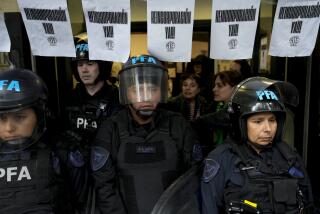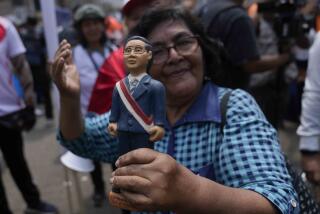Business Is Off at Peru Brothels : AIDS Scare Prompts Officials to Promote Use of Condoms
CALLAO, Peru â Every night at dusk, throngs of men from the capital of Lima come to a dusty building that looks like a warehouse in this nearby seaport to visit what may be the biggest brothel in the Western Hemisphere.
Inside the building, known as the Trocadero, red fluorescent lights shine on men wandering through halls leading to about 300 cubicles. Scantily clad prostitutes in high heels pose at many of the doors. Vendors hawk peanuts and cigarettes to clients. Salsa music blares in the background.
But the Trocadero and dozens of smaller legal brothels have seen crowds thin this year as publicity about AIDS intensifies and more Peruvians contract the disease.
A handful of prostitutes have tested positive for the virus and some prospective clients are afraid they might become infected. Health authorities are also concerned, fearing that AIDS--acquired immune deficiency syndrome--could spread rapidly through Peruâs many legal brothels.
Last month, health authorities announced âOperation Condom,â and said they would begin distributing 100,000 prophylactics at the Trocadero to curb the spread of AIDS, which is transmitted through the exchange of blood or semen.
But the health campaign at the Trocadero has underscored how widely Peruvians accept prostitution, regardless of the potential for infection.
Legal for 77 Years
Brothels have been legal in Peru since 1910 and, by most accounts, prostitution is more openly accepted here than anywhere else in Latin America.
City governments license and tax at least a score of brothels in the nation, and in 1984 the mayor of the prosperous northern oil city of Talara, making good on a campaign promise, opened a municipally owned brothel, The Red Rose. He later described it as an âinexhaustibleâ source of revenues.
Peruâs Roman Catholic Church has complained about the state role in prostitution, but to little avail, even though more than 90% of Peruvians are Catholic.
The prevailing belief is that going to a brothel âis a legitimate way for a man to be healthy, to let off steam,â said Rosa Dominga Trapasso, a Maryknoll nun who has worked with prostitutes in Lima for more than a decade.
Tradition calls on fathers to take their sons to brothels for their first sexual experience, she said.
A survey published recently in a weekly newsmagazine, Si, said that 46% of male university students had their first sexual experience with a prostitute.
6 Prostitutes Had Virus
No one has been known to contract AIDS from prostitutes in Peru, said Dr. Gottardo Aguero, a virologist who heads the AIDS unit at the Health Ministry. But six of 1,940 prostitutes checked for the presence of the AIDS virus in their blood earlier this year tested positive, he said.
Widespread publicity about AIDS in Peru, where 79 people have officially been diagnosed as carrying the disease, means that âeveryone knows what AIDS is,â Aguero said.
But misinformation about the disease is rampant, fueled by frequent and often lurid accounts in newspapers that falsely portray AIDS as a disease that can be spread by means other than the sharing of body fluids.
When health inspectors fumigated a prison, public buses and movie theaters earlier this year, newspaper accounts portrayed the measure as part of a campaign to fight AIDS. They did the same when health authorities confiscated dirty mattresses from cheap hotels.
At La Nena, a 47-room brothel in an industrial sector of Lima, a burly proprietor who declined to identify himself said the number of clients had dropped âenormouslyâ because of AIDS. Business is off by 50% since January, he said.
The fall-off is not apparent to a first time visitor to the Trocadero, which actually is three brothels in a single complex. Buses and large taxi vans continue to carry crowds of men from Lima to the Trocadero every evening.
âOn a big night, thereâs very easily 3,000 people there,â said Jim Foreit, the representative in Peru for The Population Council, a nonprofit family planning group now involved in fighting AIDS. âItâs just an enormous business.â
âI have never been in a country where there is anything to compare with the Trocadero,â he said, referring to such countries as Honduras and Panama where prostitution is legal and Brazil, where it is widely tolerated.
âMy colleagues who have worked in Thailand say that the only comparison is Thailand,â he said.
Foreit said he once saw âgroups of kids bargaining for group ratesâ at the Trocadero. The students piled out of buses and some of them âcame with book bags,â he said.
There is a reluctance among prostitutes to force their clients to wear prophylactics, he said, even though âsince the AIDS scare has been around, business has been way off.â
When Foreit surveyed 33 prostitutes at the Trocadero in September, only two said they had condoms available. âThey are afraid of losing customers because the customers donât like to use them,â he said.
Few prostitutes are in a position to demand the use of condoms, said Police Cmdr. Jose Pecho. He said 90% of prostitutes in the capital are abandoned mothers, widows or the oldest sisters in poverty-stricken families.
More to Read
Sign up for Essential California
The most important California stories and recommendations in your inbox every morning.
You may occasionally receive promotional content from the Los Angeles Times.










